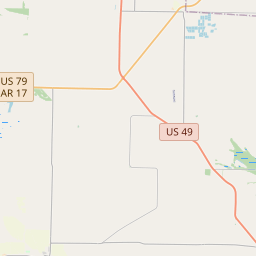Louisiana Territory: 1682-1800
Historical marker location:
Holly Grove, Arkansas
( Marker can be reached from State Highway 362, 1.8 miles east of U.S. 49.)







© OpenStreetMap contributors
Louisiana Purchase Historic State Park
The Clinton Presidential Library is located in Little Rock, Arkansas, and is dedicated to the life and legacy of former President Bill Clinton, who was the 42nd President of the United States. The library contains more than 2 million photographs, documents, and artifacts from Clinton's presidency.
About Monroe County
Monroe County Timeline
Monroe County, Arkansas has a rich history that dates back thousands of years. The area was originally inhabited by various Native American tribes, including the Quapaw and Osage, who relied on the fertile land and abundant wildlife for sustenance. European explorers, such as Hernando de Soto and French trappers, arrived in the 16th and 17th centuries.
In the early 19th century, Monroe County experienced a significant influx of settlers, primarily from the eastern United States. The county was established in 1829 and named after President James Monroe. Agriculture became the dominant industry, with plantations cultivating cotton and other crops using enslaved African Americans as labor. During this time, the county's population grew rapidly.
The Civil War had a profound impact on Monroe County. Initially, many residents supported the Confederacy, and a number of men enlisted in the Confederate army. However, the county was occupied by Union forces in 1863, leading to a shift in allegiances. Following the war, the region faced economic devastation as plantations were abandoned and former slaves sought to establish their own lives.
In the decades that followed, Monroe County slowly recovered and diversified its economy. Timber, fishing, and oil became important industries. The county also witnessed advancements in transportation, with the construction of railroads and roads that connected it to larger markets. Today, Monroe County is known for its natural beauty, outdoor recreational opportunities, and agricultural heritage.
In the early 19th century, Monroe County experienced a significant influx of settlers, primarily from the eastern United States. The county was established in 1829 and named after President James Monroe. Agriculture became the dominant industry, with plantations cultivating cotton and other crops using enslaved African Americans as labor. During this time, the county's population grew rapidly.
The Civil War had a profound impact on Monroe County. Initially, many residents supported the Confederacy, and a number of men enlisted in the Confederate army. However, the county was occupied by Union forces in 1863, leading to a shift in allegiances. Following the war, the region faced economic devastation as plantations were abandoned and former slaves sought to establish their own lives.
In the decades that followed, Monroe County slowly recovered and diversified its economy. Timber, fishing, and oil became important industries. The county also witnessed advancements in transportation, with the construction of railroads and roads that connected it to larger markets. Today, Monroe County is known for its natural beauty, outdoor recreational opportunities, and agricultural heritage.
Monroe County Timeline
This timeline provides a concise overview of the key events in the history of Monroe County, Arkansas.
- 1813 - The land that would become Monroe County was acquired from the Chickasaw Nation through the Treaty of Fort Confederation.
- 1831 - Monroe County was established as a county in the Territory of Arkansas.
- 1832 - The county seat was established in Clarendon.
- 1848 - Construction of the Little Rock and Memphis Railroad began, passing through Monroe County in the 1850s and bringing economic growth.
- 1887 - The county seat was moved from Clarendon to DeValls Bluff.
- 1944 - Camp Maxey, an army training facility, was established near the town of Clarendon and remained active until 1946.
- 1968 - The Great Flood of 1968 caused significant damage in Monroe County and led to changes in flood control measures.
- 1988 - The U.S. Army Corps of Engineers completed the Bald Knob National Wildlife Refuge, which covers portions of Monroe County.